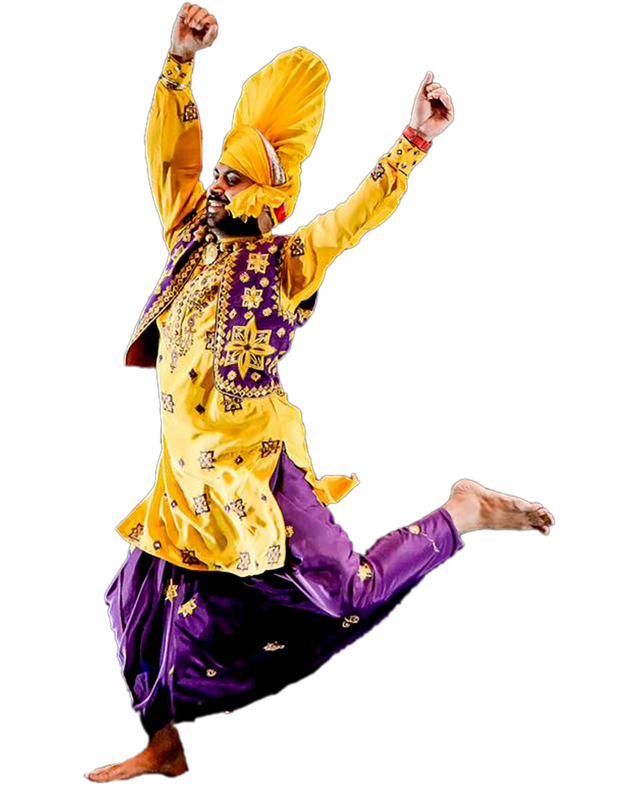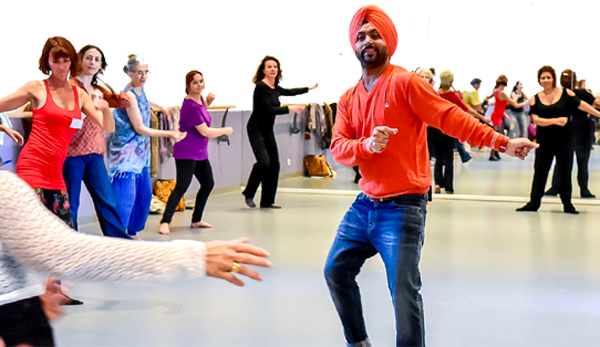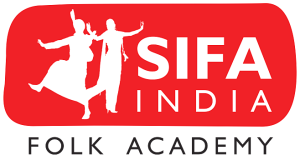COURSES AT SANJH INTERNATIONAL
Our Courses
Bhangra
Malawi Giddha
Luddi Dance
JhummerJhummer

Giddha
Sammi Dance
Jindua Dance
Malki Keema Dance
Punjabi Folk Dances (for Males)
Bhangra
Bhangra is a traditional form of dance and music which originates from the Punjab region of India and Pakistan. It was initially used as a celebratory folk dance which heralded the coming of spring, or Vaisakhi(when the farmars harvesting the field then thay start our tradisional dance called bhangra and the festival called vishakhi) as it is known.
Malawi Giddha
Malwai Giddha is the folk dance of males of Malwa region of Punjab. This dance was originally performed by Babey (old men) and hence is also called Babeyan da Gidhha but the dance is now performed by younger men too. This includes teasing of other people in Boliaan (folk poetry). The dance originated in the Malwa area of the Punjab region and is associated with the districts of Muktsar, Bathinda, Faridkot, Sangrur, Ferozpur, Mansa and Patiala. There are many teams of MalwaiGiddha performers seen performing at the Mela of village Chhapaar.
Luddi Dance
This is a disco of triumph, where people make different head movements. The costume is a loose, plain shirt. The dancers put their backs on one side, and their faces on the other. The movement of the body is sinuous and like a snake. There’s a guitarist in the dance room as well.
Jhummer
Jhumar or Jhoomar (also called Ghumbar in Sandalbar area) is a lively form of music and dance that originated in the Multan and Balochistan, also thrived in Sandalbar areas (Faisal abad, Jhang, Chiniot, Nankana Sahib, Toba Tek Singh districts) of Punjab. It is slower and more rhythmic form. The word “Jhumar” comes from Jhum/Jhoom, which means Swaying. The songs evoke a quality which reminds of swaying. Though the content of these songs is varied – they are usually love with emotional songs too. The Jhumar is a dance of ecstasy. Jhumar is performed at the wedding ceremonies usually. It is a living demonstration of the happiness. The dance is mostly performed by the Balochi and people of Southern and central Punjab. The emphasis of Jhumar is recreating the gaits of animals and birds. The movement of animals, the ploughing of the field, sowing of seeds and harvesting are shown in the original progression. The dance is also performed in circle, to the tune of emotional songs.
Punjabi folk dances (for Females)
Giddha
Giddha is a popular folk dance of women in Punjab region of India and Pakistan. The dance is often considered derived from the ancient dance known as the ring dance and is just as energetic as bhangra; at the same time it manages to creatively display feminine grace, elegance and flexibility. It is a very colourful dance form which is now copied in all regions of the country. Women perform this dance mainly at festive or social occasions.[1] The dance is followed by rhythmic clapping and a typical traditional folk song is sung by the aged ladies in the background.
Giddha varies from other forms of traditional Punjabi dance in that it does not require the two-headed barrel dhol drum to be performed. Instead, women stand in a circle formation and clap rhythms. A lead woman will recite a boli (lyrics) with a refrain that the entire circle then repeats. The whole form of a giddha song is worked through in this call and response form. Giddha details stories of women’s lives, including marriage, sexuality, domestic life, and homesickness.
Sammi Dance
Sammi is a traditional dance form originating from the tribal communities of Punjab.[1]. The dance is popular in the Sandalbar area of Punjab, Pakistan.Like Giddha it is danced in a circle. The dancers stand in a ring and swing their hands bringing them up from the sides, right in front. The refrain of the most popular Sammi song is “Sammi Meri waar..”.
Punjabi folk dances (for Males & Females)
Jindua Dance
Jindua is a famous folk dance of the Punjabis. Though the Bhangra is the most well-known of the folk dances of Punjab, the Jindua also deserves a special mention when the folk dances are spoken about. Male & Female Dancing together in this form.
Malki Keema Dance
Malki Keema is a Traditional Punjabi Dance.Malki Keema is story from the time of Mughal Emperor Akbar. Malki was the daughter of Rai Mubarak, an influential person in either Punjab or Sind. Male & Female Dancing together in this form.
Other Dance Forms
Kathak Dance
Kathak is one of the eight major forms of Indian classical dance.[1] The origin of Kathak is traditionally attributed to the traveling bards of ancient northern India known as Kathakars or storytellers.The term Kathak is derived from the Vedic Sanskrit word Katha which means “story”, and Kathakar which means “the one who tells a story”, or “to do with stories”. Wandering Kathakars communicated stories from the great epics and ancient mythology through dance, songs and music.[3] Kathak dancers tell various stories through their hand movements and extensive footwork, but most importantly through their facial expressions. Kathak evolved during the Bhakti movement, particularly by incorporating the childhood and stories of the Hindu god Krishna, as well as independently in the courts of north Indian kingdoms. Kathak is unique in having both Hindu and Muslim gharanas and cultural elements.] Kathak performances include Urdu Ghazals and commonly use instruments brought during Muslim rule.
Bollywood Dance
The filmi music and dances in Bollywood films are a synthesis of formal and folk Indian traditional music and dance traditions, in fusion with Middle Eastern techniques. The dances in older Hindi movies represented supposed dances of the common people, although they involved original choreography. Bollywood dances have evolved as a unique and energetic style. Since they are group dances, they are often used as joyful exercise music. The style of dance has also highly influenced international artists
Course Outline
- Each Level is at least 150 hours, including classes, rehearsals, performances, lectures.
- After Level 1 the student can proceed to Level 2 (another 150 hours) then another 150 hours for Level 3, according to the requirements of the academy.
- A student can continue for another 150 hours, for example: Bhangra Level 5, Khathak Level 2, and BollywoodLevel 3.
- Assuming 40 working weeks in a year: • 4 hours a week x 40 weeks = 160 hours, that is a Level in 1 year • 2 hours a week x 40 weeks = 80 hours a year, that is a Level in 2 years • 1 hour a week x 40 weeks = 40 hours a year, that is a Level in 4 years.
- This applies to all countries.


